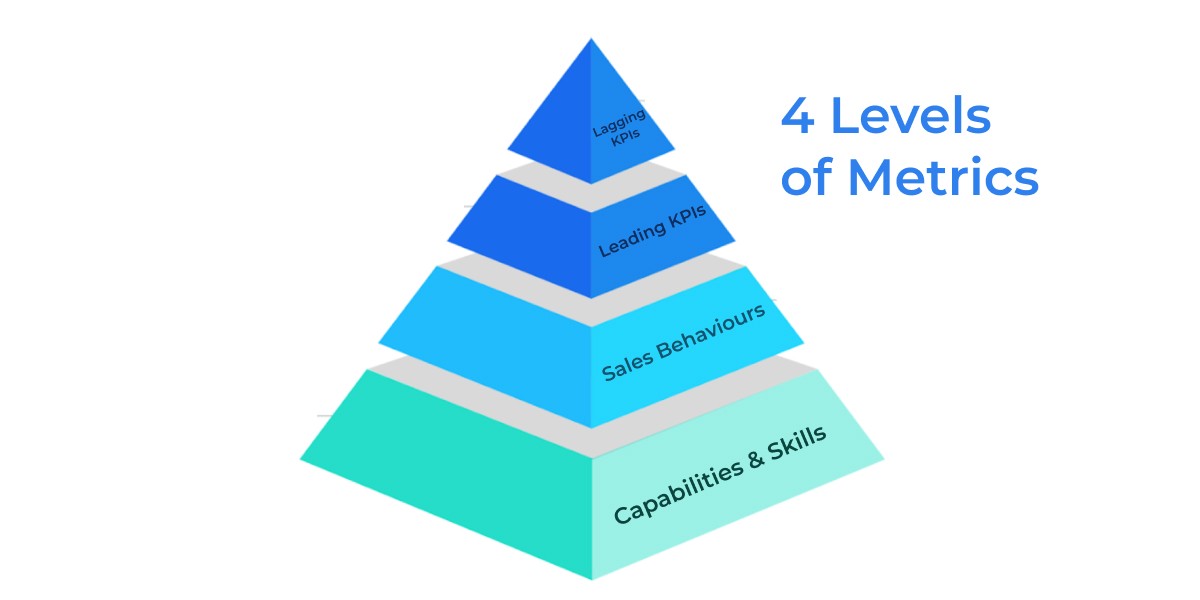
Every organisation has at one point or another undertaken a Sales Transformation programme to improve sales results.
Typically seeking to increase revenue (by increasing win rate and average deal size) or reduce cost (by making sales more productive, effective and efficient – so we can get more from the same resources).
These efforts are often rolled into ‘Sales Transformation’ programmes that focus on sales process rigour and refinement alongside a sales education efforts.
The troubling part is these transformation programmes often fail to deliver the outcomes we desire. Worse still, we’re often unable to effectively measure their impact, leaving us with no actionable insight to utilise going forward.
McKinsey’s proposes a 4-step approach to Sales Transformation in ‘The Missing Ingredient in Successful Sales Transformation’.
They insist sales leaders:
- Utilise data (& analytics) to anchor transformation
- Use test-and-learn to maximise impact
- Look at real-time insights to determine what works
- Sustain impact with personalised coaching
Albeit a logical framework, this practice is hindered by some obvious challenges.
3 Challenges Hindering Sales Transformation
1. The way we measure Sales makes it impossible to influence the outcome:
We typically measure sales success on closed revenue. We reward those top sellers with accelerated commission payments and send them on fabulous peer-envy based quota-club trips at the end of the sales year.
However, closed revenue is what is known as a ‘lagging indicator (or lagging KPI)’. And the trouble with this type of measure is that it’s a ‘rear-facing’, ‘after the fact’ metric; meaning it’s impossible to influence because it’s already happened.
2. There’s no easy way to measure impact of Sales Training:
It’s because we measure Sales success around closed revenue alone that we often fall victim to the old and tired silver bullet; sales training.
However, how do we quantify the impact this training has on our sales team? Do we really know if it sunk in? Is it being put to use? Will it sustain over time? Did it have any impact on our key lagging indicator of closed revenue?
Painful though it might be to admit it, we can’t answer these questions because we have no real way of tracking the impact our training is having on our closed revenue.
Sales Training in isolation is a “High Effort” and “Low Impact” approach that may be costing the business more money than it’s getting back – and we’d have no way of knowing that.
We need to stop having blind faith in this practice and instead create a cause-and-effect approach between training imparted and revenue banked.
Traditional stand-alone training and coaching are high-effort but low-impact. Successful Sales Transformation Programmes are harnessing the low-effort and high-impact approach afforded by ‘sales behaviours’.
3. No visibility into Leading Indicators:
Some progressive sales organisations are starting to gravitate towards ‘leading’ indicators as a more accurate way to influence closed revenue; bridging the measurement gap between transformation tactic and sales outcomes.
Leading indicators (or ‘leading KPIs’) are forward-facing measures that you can influence as they are yet to happen. They light up the pathway towards lagging indicators, contributing to the rear-facing outcome everyone wants.
What do we mean by leading indicators? These are measure such as:
- Always having a Healthy Pipeline (with strong coverage by stage)
- Complete Territory Coverage (are you hitting accounts across your whole territory)
- Sales Productivity Metrics (such as customer contact cadence rates)
- Sales Effectiveness Metrics (such as Social Selling Index score)
- Sales Process Metrics (such as ensuring you are following the prescribed ‘winning way’)
These forward-facing measures contribute to us hitting the ‘lagging indicator’ we desire the most – yep, you got it – closed revenue.
Organisations who have adopted this approach are at least heading in the right direction. But they are still missing one crucial final step.
How can that be? We have our measures – both lagging and leading indicator(s) and we are training (and hopefully also coaching) our reps. What could possibly be missing?
The Missing Link: Sales Behaviour Data
Leading sales organisations have realised there is a missing link. A type of glue that links together leading metrics to lagging outcomes, that is able to show us the true resonance of training and brings about clear gaps in performance.
That missing link is sales activity data – or as we much rather call it – sales behaviours.
What do we mean by sales behaviours?
CRM systems have sullied the term ‘sales activity’. When we think of ‘sales activity’, we immediately think of the recording of simplistic activities like, ‘I made a call’, ‘I sent an email’ etc.
But what sales leaders really need to measure the attainment of leading indicators is a deeper view into the actions of reps – both good and bad. These are multifaceted and complex, and are not typically recorded by the CRM system alone.
Which is why we refer to it as sales behaviour and not mere ‘activity’.
This example will help better illustrate the difference:
Let’s take a Leading Indicator like ‘Ensure a Healthy Pipeline’.
The positive and negative sales behaviours that will have an impact on this leading indicator might include:
Sales Behaviours (Positive):
- Lead qualified within 48 hours
- New Opportunity Created
- >3 Products attached to Opportunity
- Account with >3 Opportunities
- Competitor Identified/Added
- 5 Open Opportunities in each pipeline stage
Sales Behaviours (Negative):
- Close Date Pushed Out in Commit
- Account (1+ year) With No Sales Activity
- No Opp Updates in 180 Days
- Opp in Same Stage for > 30 Days
These are the steps that, if encouraged, will contribute to making our leading indicators healthy. Which in turn will make sure we hit our lagging indicator of closed revenue.
CRM systems alone can not track this. Focusing solely on sales activity will not give us this level of insight.
What we need to measure true Sales Transformation is real-time tracking of sales behaviours, so we can grade the impact of training and understand if that impact is sustained against our original performance baseline.
At the same time, transparency into behaviours around specific deals will help us to influence their outcome. Insight into overall rep behaviours will also help us build better training and coaching programmes.
It is only by tracking and promoting better sales behaviours that we’ll be able to drive attainment of our leading KPIs, in turn influencing our all important lagging KPIs.
Measuring sales behaviours is an approach that our customer Vodafone has been following since 2015. Since then, they have gathered 21M data points that have helped them correlate training efforts with sales outcomes.

They’ve been able to build a clear pathway between imparted training, how this enhanced rep’s skills and behaviours, the leading KPIs influenced by the team and how these contributed to the final number.
Insight like this has delivered them:
- 20% increase in win rate
- 95% forecast accuracy
- 60% more selling time
- 19% increase in average deal size
The True 4-Steps of Successful Sales Transformation
At the beginning of this article we looked at a 4-step approach recommended by McKinsey to deliver successful Sales Transformation:
- Utilise data (& analytics) to anchor transformation
- Use test-and-learn to maximise impact
- Look at real-time insights to determine what works
- Sustain impact with personalised coaching
However, we argued that the average sales organisation wouldn’t have enough data to really follow through on these recommendations.
Now that we’ve looked at the missing ingredient – tangible behavioural data – we’re in a better position to actually deliver a cause-effect relationship for our transformation programme.
It’s thanks to this deeper layer of insight that we can:
- Baseline current sales achievement against your chosen sales performance metric (broken down into behaviours)
- Test, learn and course correct your transformation efforts in real-time and with confidence – through data-driven insight into sales behaviours
- Measure the achievement of your leading indicators (and hence correlate the impact on your desired lagging indicator of closed revenue)
- Finally, be able to create a highly personalised, data-driven coaching improvement plan based on easily identifiable skill gaps.
Lastly, there is another benefit from this approach – the tracking of these sales behaviours allows for the automation of sales improvement.
By feeding sales behaviour data along with standard Opportunity and Account information into an AI-engine, it delivers intelligence that will help your sales managers and reps alike with:
- AI-driven deal predictions – that are right over 95% of the time – highlighting not just if the deal will close but crucially when and for how much
- AI-driven guided selling prompts offering ‘next best action’ advice (and best action to avoid) that frees up 60% more selling time
Your next Sales Transformation programme could be automated, data-driven, proven and repeatable. Guaranteeing real impact on your closed revenue without changes to tech stack, process or personnel.
And that, is worth your time and monetary investment.

